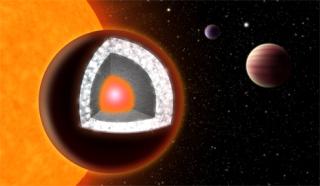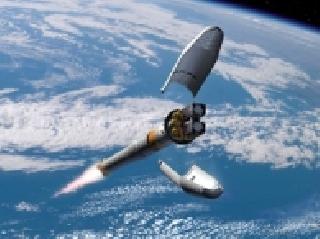
Illustration of the interior of 55 Cancri e- an extremely hot planet with a surface of mostly graphite surrounding a thick layer of diamond, below which is a layer of silicon-based minerals and a molten iron core at the centre. Photo: Haven Giguere.
WASHINGTON (AFP): Twinkling stars are not the only diamonds in the sky. Scientists have reported the existence of a "diamond planet" twice the size of Earth, and eight times its mass, zooming around a nearby star.
In fact, this is not the first diamond planet ever discovered, but it is the first found orbiting a sun-like star and whose chemical makeup has been specified.
The discovery means that distant rocky planets can no longer be assumed to have chemical constituents, interiors, atmospheres, or biologies similar to those of Earth, said lead researcher Nikku Madhusudhan, a Yale postdoctoral researcher in physics and astronomy.
The planet was first observed last year -- but researchers initially assumed it was similar in its chemical make-up to Earth.
It was only after a more detailed analysis that the French-American research team determined the planet is vastly different from our own.
It "appears to be composed primarily of carbon (as graphite and diamond), iron, silicon carbide, and, possibly, some silicates," the authors wrote in a statement ahead of their findings' publication in the US journal "Astrophysical Journal Letters."
"The surface of this planet is likely covered in graphite and diamond rather than water and granite," he explained.
In fact, the planet, dubbed Cancri 55 e, appears to have no water at all. And as much as a third of the planet's substantial mass could be made of diamond, a super-dense compound of carbon.
In comparison, the Earth's interior is rich in oxygen and very poor in carbon, explained Kanani Lee, also of Yale and another of the study's co-authors.
The researchers estimated the planet's radius with data collected while it was transiting in front of its star.
That information, combined with an estimate of its mass, was used to model the planet's chemical composition, based on a calculation of just what elements and compounds could result in that specific size and mass.
The planet's orbit around its star is lightning fast -- a year lasts just 18 hours, compared to the 365 days of an Earth year. And because it is so close to its star, the surface temperatures average 3,900 degrees Fahrenheit (2,148 degrees Celsius), rendering it completely inhospitable to life.
But the planet -- 40 light years away from Earth in the Cancer constellation -- opens new avenues for studying geochemical and geophysical processes of Earth-sized planets outside our solar system.
 Previous Article
Previous Article Next Article
Next Article













The Indian Air Force, in its flight trials evaluation report submitted before the Defence Ministry l..
view articleAn insight into the Medium Multi-Role Combat Aircraft competition...
view articleSky enthusiasts can now spot the International Space Station (ISS) commanded by Indian-American astr..
view article